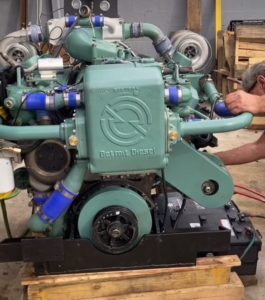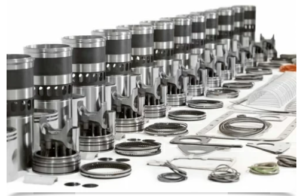February 25, 2025
Understanding Blowby in 92 Series Engines
Causes of Blowby in Detroit Diesel 92 Series Engines
1. Worn or Damaged Piston Rings
2. Cylinder Liner Wear
3. Excessive Carbon Deposits
4. Glazed Cylinder Walls
5. Crankcase Ventilation Issues
6. High Engine Hours Without Overhaul
Symptoms of Excessive Blowby in Detroit Diesel 92 Series Engines
1. Visible Smoke or Mist from the Crankcase Breather
2. Increased Oil Consumption
3. Reduced Engine Power and Efficiency
4. Increased Exhaust Emissions
5. Oil Leaks Due to Excessive Crankcase Pressure
Regular Inspections and Maintenance for Blowby Prevention
Testing for Blowby in 92 Series Engines
Preventing and Reducing Blowby
Repairing Blowby Issues
Conclusion
Read More
February 25, 2025
Introduction
Auxiliary Drive Overview
Auxiliary Drive Positions and Ratios
Understanding Drive Ratios
Mounting Locations and Drive Mechanism
Front-Mounted Accessory Drive
Rear-Mounted Accessory Drive
Blower Drive Integration
Types of Auxiliary Drive Systems
Direct-Driven Accessories
Belt-Driven Accessories
Left-Bank Accessory Drive
Auxiliary Drive Maintenance
Inspection
Repair or Replacement Procedures
Common Issues and Troubleshooting
Excessive Gear Wear
Oil Leaks
Belt Slippage
Conclusion
Read More
February 25, 2025
What is Air-to-Fuel Ratio (AFR)?
How AFR Works in Diesel Engines
Effects of AFR on Engine Performance
AFR in Detroit Diesel 92 Series Engines
Key Parameters Affecting AFR
Fuel Injector Selection
Boost Pressure from Turbocharger
Blower Drive Ratio
Exhaust Backpressure
Governor and Fuel Modulation
Optimal AFR and Engine Performance in Detroit Diesel 92 Series Engines
Ideal AFR for Diesel Combustion
Effects of Incorrect AFR
Effects of a Rich AFR (Low Air-to-Fuel Ratio)
Symptoms of a Rich AFR:
Common Causes of a Rich AFR:
Effects of a Lean AFR (High Air-to-Fuel Ratio)
Symptoms of a Lean AFR:
Common Causes of a Lean AFR:
Maintenance Tips to Ensure Proper AFR
Air Intake System Maintenance
Fuel System Maintenance
Exhaust System Maintenance
Why Maintaining an Optimal AFR Matters
Read More
February 24, 2025
What the Camshaft Drives
Camshaft Bearings and Lubrication
Key Points for Proper Camshaft Bearing Maintenance:
Camshaft Removal and Inspection
Removal Procedure
Inspection Criteria
Camshaft Installation Procedure
Step 1: Lubricate Bearings and Camshaft Lobes
Step 2: Align Camshaft Timing Marks
Step 3: Carefully Insert the Camshaft
Step 4: Reinstall Retaining Bolts and Gear Cover
Step 5: Reassemble Injectors, Rockers, and Valve Covers
Final Checks Before Engine Startup
Camshaft Timing and Adjustment
Steps for Proper Timing
Additional Timing Considerations
Common Camshaft Issues and Troubleshooting
1. Excessive Wear on Lobes
2. Noisy Valve Train
3. Engine Misfires
4. Metal Shavings in Oil
Preventive Maintenance for Camshafts
Read More
January 8, 2025
Importance of Fuel Injectors
Signs Indicating Injector Replacement
Recommended Injector Replacement Timing
Mechanical Injectors for Detroit Diesel 16V92 Engines
Features of Mechanical Injectors
When to Replace Mechanical Injectors
Maintenance Tips for Mechanical Injectors
Electronic Injectors for Detroit Diesel 16V92 Engines
Features of Electronic Injectors
When to Replace Electronic Injectors
Maintenance Tips for Electronic Injectors
Advantages of Electronic Injectors
Step-by-Step Guide for Injector Replacement
Maintenance Tips to Extend Injector Life
Conclusion
Read More
January 8, 2025
Introduction
Key Specifications
Turbocharged Variants: Aftercooled and Intercooled Configurations
Aftermarket Support for Detroit Diesel 12V92 Marine Engines
Available Parts
Recommended Sources
Maintenance and Troubleshooting
Preventive Maintenance:
Common Issues:
Read More
Page 1 of 1012345...10...»Last »




 Free US Calls: 1-888-433-4735
Free US Calls: 1-888-433-4735 International: 305-545-5588
International: 305-545-5588

